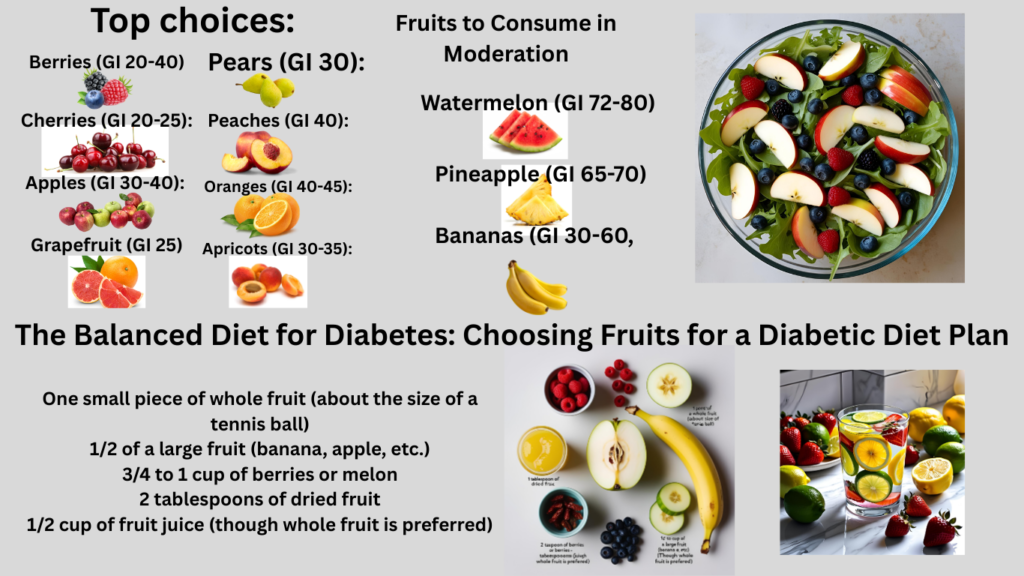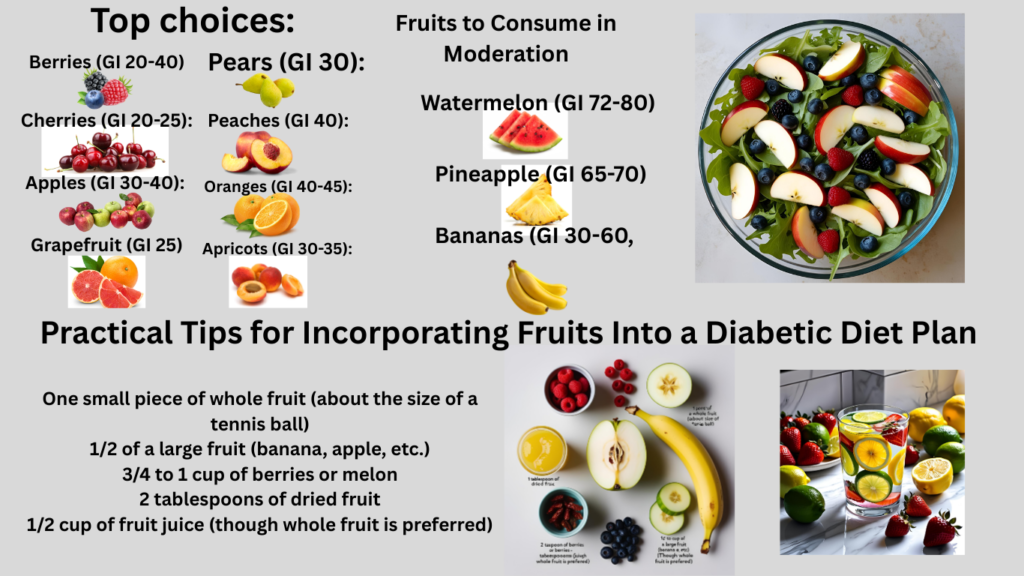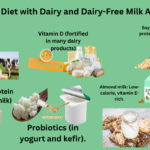
Introduction: Rethinking Fruit in Diabetes Management
Did you know that people with diabetes can—and should—enjoy fruit as part of a healthy diet? According to the American Diabetes Association (ADA), whole fruits are packed with essential vitamins, minerals, and fiber to help manage blood sugar levels when consumed appropriately. Yet nearly 50% of people with diabetes report avoiding fruit unnecessarily due to misconceptions about sugar content. The Balanced Diet for Diabetes: Choosing Fruits for a Diabetic Diet Plan
Prioritise. The relationship between fruit consumption and diabetes management involves a delicate balance. While fruits contain natural sugars, they also offer valuable nutrients that support overall health. The key lies in understanding which fruits to prioritise, how to incorporate them effectively into your diet, and dispelling the myths that may have limited your food choices unnecessarily.
This comprehensive guide will explore the science behind fruit consumption for people with diabetes, provide practical advice for selecting the best fruits, and offer strategies for creating a balanced diet that satisfies your sweet tooth while maintaining healthy blood glucose levels. The Balanced Diet for Diabetes: Choosing Fruits for a Diabetic Diet Plan
Understanding the Glycemic Impact of Fruits
Mechanisms of Action: How Fruits Affect Blood Sugar
The body processes carbohydrates from different foods at varying rates, directly impacting blood glucose levels. Two critical measures quantify this variation: glycemic index (GI) and glycemic load (GL).
Glycemic Index Explained
The glycemic index assigns a numeric score to carbohydrate-containing foods based on how quickly they raise blood sugar levels. According to Harvard Health, foods are ranked on a scale of 0 to 100, with pure glucose given a value of 100:
- Low GI (55 or less): Slow, gradual increase in blood sugar
- Medium GI (56-69): Moderate increase in blood sugar
- High GI (70 or above): Rapid spike in blood sugar
Glycemic Load: The Complete Picture
While the glycemic index tells part of the story, glycemic load provides a more complete picture by considering both the quality (GI) and quantity of carbohydrates in a typical portion. This helps explain why some high-GI fruits like watermelon (GI of 80) have a relatively low impact on blood sugar when consumed in typical serving sizes—its glycemic load is only five due to its high water content and relatively low carbohydrate amount per serving.
The Fiber Factor
What makes many fruits diabetes-friendly despite their sugar content? The answer mainly lies in their fiber content. Dietary fiber—particularly soluble fiber—slows digestion and the absorption of sugars, resulting in more gradual increases in blood glucose levels. Registered dietitian Kate Patton of the Cleveland Clinic explains, “Fiber slows down digestion. That helps us feel full longer and prevents spikes in blood sugar.”
A 2021 study published in the Journal of Clinical Endocrinology & Metabolism found that people who eat a diet rich in whole fruits have a lower risk of developing type 2 diabetes. The researchers attributed this protective effect to whole fruits’ fiber content and bioactive compounds.
Best Fruit Choices for Diabetes Management

Low-Glycemic Fruits to Emphasize. When selecting fruits for a diabetes-friendly diet, emphasising those with a low glycemic index can help maintain stable blood sugar levels. According to the Cleveland Clinic, the following fruits have a low glycemic index (under 55) and should be considered top choices:
- Berries (GI 20-40): Strawberries, blueberries, raspberries, and blackberries are excellent choices. One cup of fresh blueberries contains 84 calories and 21 grams of carbohydrates but delivers an impressive amount of fiber and antioxidants.
- Cherries (GI 20-25): These ruby-red fruits are packed with antioxidants and have one of the lowest glycemic indexes among fruits.
- Apples (GI 30-40): With approximately 4 grams of fiber per medium fruit, apples help slow digestion and regulate blood sugar. The USDA notes that a medium apple contains about 95 calories and 25 grams of carbohydrates.
- Pears (GI 30): An excellent source of fiber, with nearly 5.5 grams per medium fruit, pears make a satisfying and blood-sugar-friendly snack.
- Grapefruit (GI 25): This citrus fruit contains compounds that may help improve insulin sensitivity, making it doubly beneficial for diabetes management.
- Apricots (GI 30-35): These tiny fruits pack a nutritional punch—four fresh apricots provide just 17 calories and 4 grams of carbohydrates each, and a good vitamin A dose.
- Peaches (GI 40): A medium peach contains about 59 calories and 14 grams of carbohydrates, potassium, and vitamin C.
- Oranges (GI 40-45): One medium orange provides 65 calories, 16 grams of carbohydrates, and an excellent source of vitamin C—nearly 63 mg, which is most of the daily requirement.
Fruits to Consume in Moderation
While no fruits need to be eliminated from a diabetic diet, some have a higher glycemic index and should be consumed in smaller portions or less frequently:
- Watermelon (GI 72-80): Despite its high GI, watermelon has a low glycemic load due to its high water content. Enjoy in moderation—about 1 cup of cubed watermelon.
- Pineapple (GI 65-70): While nutritious, pineapple has a higher sugar content. Limit to ½ cup portions.
- has a medium GIMango (GI 55-60): This tropical fruit sits in the medium GI range. Enjoy half a mango rather than a whole one.
- Bananas (GI 30-60, depending on ripeness): Riper bananas have a higher GI. Choose slightly underripe bananas with some green on the peel for a lower glycemic impact. The Balanced Diet for Diabetes: Choosing Fruits for a Diabetic Diet Plan
The Form Matters: Whole vs. Processed Fruits
The way you consume fruit significantly impacts its effect on blood sugar:
Whole Fruits vs. Fruit Juice
A randomised trial published in the Journal of Nutrition in 2013 found that consuming whole fruits led to better glycemic control than fruit juices. This is because juicing removes the fiber while concentrating the sugars. As the American Diabetes Association advises, eating fruit in its whole form is better than drinking fruit juice.
Fresh vs. Dried and Canned
Dried fruits have a concentrated sugar content due to the removal of water. For example, just two tablespoons of raisins contain as many carbohydrates as a small apple. When choosing canned fruits, choose varieties packed in water or juice rather than syrup, which adds unnecessary sugars.
Common Myths About Diabetes and Fruit Consumption
Myth vs. Fact: Setting the Record Straight
Myth 1: People with diabetes should avoid all fruit.
Fact: This is perhaps the most persistent and harmful myth. The American Diabetes Association states that whole fruits are a healthy part of a diabetes meal plan. A 2013 randomised trial published in Nutrition Journal found that restricting fruit intake in patients with type 2 diabetes had no beneficial effect on glycemic control, weight loss, or waist circumference. The researchers concluded, “We recommend that the intake of fruit should not be restricted in patients with type 2 diabetes.”
Myth 2: Fruit contains too much sugar for people with diabetes.
Fact: While fruits do contain natural sugars, they also provide fiber, vitamins, minerals, and antioxidants that can help with blood sugar management. The natural sugars in fruit are different from added sugars in processed foods because they come packaged with fiber that slows digestion and absorption.
uniqueMyth 3: Diabetics need unique “diabetic” fruit products.
Fact: According to the British Heart Foundation, foods explicitly marketed for people with diabetes—including unique fruit products—are often unnecessary, expensive, and sometimes contain sugar alcohols that can have a laxative effect when consumed in large amounts. Whole, fresh fruits are the best choice.
Myth 4: All fruits have the same effect on blood sugar.
Fact: Different fruits have significantly different effects on blood glucose levels based on their fiber content, sugar content, and overall composition. The glycemic index and glycemic load provide good guidelines for understanding these differences.
Myth 5: Fruit should be avoided for weight management in diabetes.
Fact: Studies have consistently shown that fruit consumption is associated with weight maintenance or weight loss. A study published in Metabolism 2011 found that a diet containing moderate amounts of natural fructose from fruit led to more significant weight loss than a low-fructose diet.
| Unique Myth | Fact |
|---|---|
| People with diabetes should avoid all fruit | Whole fruits are recommended as part of a healthy diabetes meal plan |
| Fruit has too much sugar for diabetics | The fiber in whole fruit slows sugar absorption, reducing blood sugar spikes. |
| Special “diabetic” fruit products are necessary | Whole, fresh fruits are the healthiest and most economical choice |
| All fruits affect blood sugar equally | Different fruits have varying effects based on their glycemic index and load. |
| Fruit prevents weight loss | Research shows fruit can aid weight management when consumed appropriately |
Practical Tips for Incorporating Fruits Into a Diabetic Diet Plan

Portion Control and Timing
Determining Appropriate Portions
According to the Mayo Clinic, a single serving of fruit for people with diabetes should contain approximately 15 grams of carbohydrates. This generally translates to:
- One small piece of whole fruit (about the size of a tennis ball)
- 1/2 of a large fruit (banana, apple, etc.)
- 3/4 to 1 cup of berries or melon
- 2 tablespoons of dried fruit
- 1/2 cup of fruit juice (though whole fruit is preferred)
Timing Fruit Consumption
When you eat fruit, it can be as important as what you eat. Consider these timing strategies:
- Pair fruit with protein or healthy fats: Combine fruits with protein-rich foods like Greek yogurt or a small handful of nuts to slow digestion and reduce the glycemic impact.
- Distribute throughout the day: Rather than consuming all your daily fruit at once, spread your intake throughout the day to prevent large spikes in blood sugar.
- Consider activity levels: Consuming fruit before or after physical activity can be beneficial, as your muscles are more receptive to glucose during these times.
Creative Ways to Enjoy Fruits
The Balanced Diet for Diabetes: Choosing Fruits for a Diabetic Diet Plan
Morning boost: Add berries to oatmeal or unsweetened Greek yogurt for a nutritious breakfast.
- Salad enhancement: Toss sliced apples or berries into green salads for added nutrition and flavor.
- Frozen treats: Freeze grapes or banana slices for a refreshing snack that takes longer and prevents rapid sugar increases.
- Fruit-infused water: Add slices of citrus or berries to water for a refreshing, sugar-free beverage with a hint of flavor.
- Grilled delights: Grill peach halves or pineapple slices for a caramelised treat that can satisfy a dessert craving.
Meal Planning Strategies
The Plate Method
The American Diabetes Association recommends the plate method for meal planning, which can include fruit:
- Fill half your plate with non-starchy vegetables.
- Fill a quarter with lean protein.
- Include a quarter of carbohydrates, including a small portion of fruit.
- Add a small piece of whole fruit or 1/2 cup of fruit salad as dessert
Carbohydrate Counting
If you use carbohydrate counting to manage your diabetes:
- Count fruit as part of your total carbohydrate budget for each meal.
- Remember that one fruit serving typically contains 15 grams of carbs.
- Substitute fruit for other carbohydrate sources in your meal plan
The Role of Fruits in Overall Diabetes Management
Beyond Blood Sugar: Comprehensive Health Benefits
Fruits offer numerous health benefits beyond their impact on blood glucose levels, many of which are particularly important for people with diabetes:
Cardiovascular Protection
People with diabetes have a higher risk of heart disease. Many fruits contain compounds that support heart health:
- Berries: Rich in anthocyanins, these compounds may improve arterial function and reduce inflammation.
- Citrus fruits: Contain hesperidin and naringin, which may help lower blood pressure and improve lipid profiles.
A 2011 study published in Diabetologia found that greater consumption of low-GI fruits was associated with improved glycemic control and reduced cardiovascular risk factors in people with type 2 diabetes.
Weight Management Support
Maintaining a healthy weight is crucial for diabetes management. Fruits can help by:
- Providing filling fiber with relatively few calories
- Offering natural sweetness to satisfy cravings
- Displacing higher-calorie processed foods in the diet
Micronutrient Support
Diabetes can increase the need for certain nutrients, many of which are abundant in fruits:
- Vitamin C: Found in citrus, berries, and kiwi, vitamin C supports immune function and wound healing.
- Potassium: In bananas, oranges, and apricots, potassium helps maintain healthy blood pressure.
- Antioxidants: Protect cells from oxidative damage, which is accelerated in poorly controlled diabetes.
Integrating Fruit Into a Comprehensive Diabetes Care Plan
Fruit consumption should be viewed as one element of a holistic approach to diabetes management that includes:
Regular monitoring: Track how different fruits affect your blood glucose levels.
- Physical activity: Regular exercise works synergistically with diet to improve insulin sensitivity.
- Medication adherence: If prescribed medications for diabetes, take them as directed by your healthcare provider.
- Regular healthcare visits: Maintain scheduled appointments for diabetes management and monitoring.
- Education: Stay informed about diabetes management strategies and nutritional recommendations as research evolves.
Q&A Section: Your Questions About Fruits and Diabetes Answered
Q1: Can eating fruit raise my blood sugar too much?
I’d like you to monitor A: Whole fruits, when consumed in appropriate portions, generally have a moderate effect on blood sugar due to their fiber content. However, individual responses vary. I’d like you to monitor your blood glucose after eating different fruits to understand your response. Pairing fruit with protein or healthy fats can generally reduce its glycemic impact.
Q2: How much fruit can I safely eat with diabetes?
A: The American Diabetes Association doesn’t specify a limit on fruit servings but recommends including fruit in a balanced diet. Most dietary guidelines suggest 2-3 servings of fruit daily. A single serving contains approximately 15 grams of carbohydrates. Please work with your healthcare provider or a registered dietitian to determine the right amount for your needs.
Q3: Is fruit juice as healthy as whole fruit for people with diabetes?
A: No. Fruit juice lacks the fiber of whole fruit and has a concentrated sugar content that can raise blood glucose more rapidly. The American Diabetes Association recommends limiting fruit juice and prioritising whole fruits instead. If you choose juice, limit to a 4-ounce serving and select 100% fruit juice with no added sugars.
Q4: Are dried fruits suitable for a diabetic diet?
A: Dried fruits are more concentrated in sugars and calories than their fresh counterparts. While they can be included in a diabetes meal plan, portion control is essential. Limit dried fruit to about two tablespoons per serving, and consider fresh fruit a more filling alternative.
Q5: Can fruit help prevent type 2 diabetes?
A: Research suggests that a diet rich in whole fruits may help reduce the risk of developing type 2 diabetes. A 2013 study published in the BMJ found that greater consumption of specific whole fruits, particularly blueberries, grapes, and apples, was significantly associated with a lower risk of type 2 diabetes.
Q6: Do artificial sweeteners offer a better alternative to fruit for satisfying sweet cravings?
A: While artificial sweeteners don’t raise blood sugar, they don’t provide the nutritional benefits of fruit. Whole fruits offer fiber, vitamins, minerals, and antioxidants that support overall health. Many health organisations recommend satisfying sweet cravings with moderate portions of whole fruit rather than artificial alternatives.
Q7: Should I avoid fruits completely when my blood sugar is running high?
A: Rather than eliminating fruits during periods of elevated blood sugar, consider choosing fruits with a lower glycemic index and reducing portion sizes. Berries, apples, and pears are good options. Always consult your healthcare provider for personalised advice during periods of poor glycemic control.
Conclusion: Embracing Fruits as Part of a Balanced Diabetic Diet
The relationship between fruit consumption and diabetes management is more nuanced than many realise. While myths about avoiding fruit entirely have persisted, current evidence supports including whole fruits as part of a balanced diet for people with diabetes.
By understanding the glycemic impact of different fruits, practicing appropriate portion control, and incorporating fruits strategically into meals, people with diabetes can enjoy these nutritious foods while maintaining healthy blood glucose levels. The fiber, vitamins, minerals, and antioxidants in fruits provide essential nutrients that support overall health and may help manage or prevent diabetes-related complications.
Remember that individual responses to fruits may vary. Working with healthcare providers and monitoring blood glucose levels can help identify the fruits and portions that work best for your diabetes management plan.
Rather than viewing fruits as forbidden foods, consider them valuable allies in your journey toward better health with diabetes. A balanced approach that includes a variety of low-to-moderate glycemic index fruits can help manage blood sugar and enhance the quality, enjoyment, and sustainability of your diet.
References
- American Diabetes Association. (2023). Fruit. Retrieved from https://diabetes.org/food-nutrition/reading-food-labels/fruit ADA Official Website
- Christensen, A. S., Viggers, L., Hasselström, K., & Gregersen, S. (2013). Effect of fruit restriction on glycemic control in patients with type 2 diabetes–a randomized trial. Nutrition Journal, 12, 29. Nutrition Journal
- Harvard Health Publishing. (2023). The lowdown on glycemic index and glycemic load. Harvard Medical School. Harvard Health
- Jenkins, D. J., Srichaikul, K., Kendall, C. W., et al. (2011). The relation of low glycaemic index fruit consumption to glycaemic control and risk factors for coronary heart disease in type 2 diabetes. Diabetologia, 54(2), 271-279. Diabetologia



Pingback: Can Acai Berries Boost Your Immunity? - mysproutapp.com